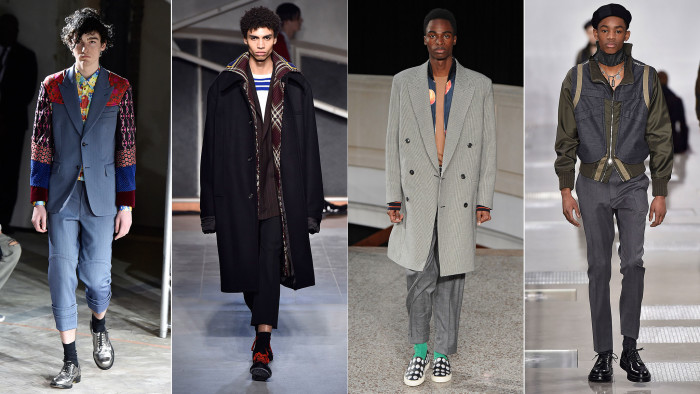Paris Menswear AW16 round-up

Simply sign up to the Life & Arts myFT Digest -- delivered directly to your inbox.
In a Paris of middle-aged menswear favourites — say hello to the era of the double-breasted coat — somehow the AW16 shows felt young and new. As seen in London and Milan, menswear has taken a turn for the wearable. It’s also directional: of the 832 looks I saw in Paris, only 43 involved a tie. That’s just 5 per cent with old formality. The rest were pushing somewhere fresh.
It can be very effective when young men wear oversized tailored coats: think of early Morrissey, or 24-year-old James Dean walking in the rain through Times Square. Most of the models at these men’s shows are kids, and it was this mood of young-wearing-old that popped in the excellent long double-breasted coats at Paul Smith, the knee-length black double-breasted coat at Hermès, or the double-breasted coat worn with a crew-neck sweater at Berluti.
This oversized silhouette sung at Raf Simons, a show marking 20 years of his own label, and his first since quitting as creative director at Dior. Straight after the show, it was the extraordinary oversized and decayed varsity sweaters that stuck in the mind. Looking back now, what resonates is a simple oversized black wool coat worn by a young model from Norwich called Sol Goss, its cuffs falling way past his hands.
Some used tailoring for new purpose or a message. For the catwalk debut of his label Off-White, Kanye West collaborator Virgil Abloh used full tailored looks of the same cloth — coat, jacket, wide pants — to show how far this T-shirt brand has come. Junya Watanabe integrated solar panels into coats, which will take five hours to charge a USB battery. The cut of his coats and suits was as admirable as his intent. At Comme des Garçons, Rei Kawakubo created articulated sleeves like soft armour on tailoring, the fabric often patterned or floral. Her point was quiet and strong: clothing of aggression can also be a sign of peace.
What’s on a catwalk says much about a brand, but often the real story is in the showroom. This is where buyers place their orders, and the showroom for young Russian designer Gosha Rubchinskiy was so rammed, it was hard to get to the rails. So many stores want to buy into the evocative adolescence of his clothing, which has a price point deliberately low enough to make it affordable for men of actual youth, not just those clawing back the years.
Rubchinskiy did something clever. Much of the collection was purposefully drab, like a grey duffel, or plaid shirts. Mixed with these were sweatshirts and trackpants with a simple design intervention: a second cuff hole at the wrist or by the ankle. Should the wearer use this one rather than the other, the extra cloth banged around behind. Immediate teenage belligerence.
A quick word about zip-ups, which have become such a norm on the catwalk that they can escape attention. At Louis Vuitton, Kim Jones sent out some great blousons of utilitarian panelling worn with tailored pants, a look also seen at Givenchy. Meanwhile some were in a world of their own, like the super-cropped jackets at Rick Owens, or the exaggerated silhouettes in specially developed fabrics of Ximon Lee.
And the majority of those 43 ties? They were on the catwalk of Thom Browne, a singular designer whose study of ageing in clothing and humans was one of the shows of the week.
It’s one of the clearest seasons in a while, with a look that’s easy to translate into real life. Forget next winter: try a double-breasted coat with a crewneck sweater right now.
But the season is not all over yet. New York men’s week is about to begin, and, more importantly, Saint Laurent has decided to show its collection in Los Angeles on February 10. A spanner could be thrown into these straightforward menswear works yet.
Charlie Porter is the FT’s men’s fashion critic
For more reports from the shows, go to our fashion weeks page
Photographs: Catwalking
Comments